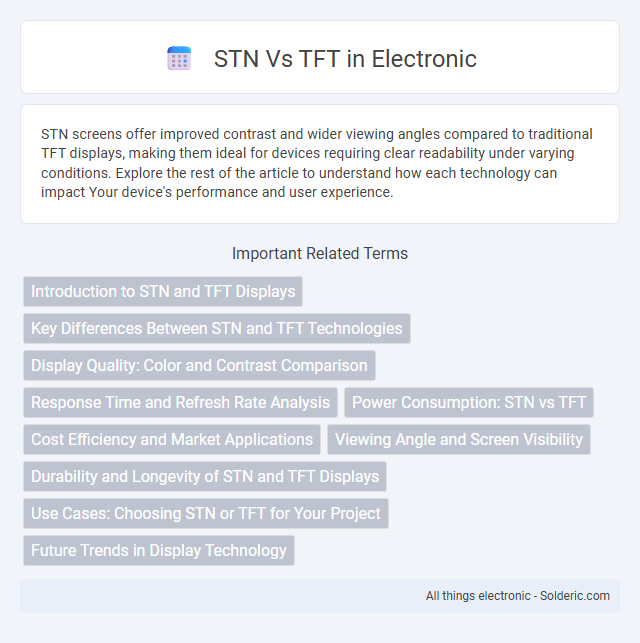STN screens offer improved contrast and wider viewing angles compared to traditional TFT displays, making them ideal for devices requiring clear readability under varying conditions. Explore the rest of the article to understand how each technology can impact Your device's performance and user experience.
Comparison Table
| Feature | Spatial Transformer Network (STN) | Transformer (TFT) |
|---|---|---|
| Primary Purpose | Learn spatial transformations for input alignment | Handle sequential data with attention mechanism |
| Core Mechanism | Learnable affine transformations applied to feature maps | Self-attention layers capturing temporal dependencies |
| Application Domain | Computer vision - image recognition, object detection | Time series forecasting, NLP, sequential modeling |
| Input Data | Images or feature maps | Multivariate time series or sequences |
| Output | Spatially transformed inputs for improved downstream tasks | Predicted sequences or forecasts |
| Main Advantage | Improves spatial invariance and alignment | Captures long-term dependencies efficiently |
| Model Complexity | Lightweight spatial module integrated into CNNs | Complex multi-head attention networks |
Introduction to STN and TFT Displays
STN (Super Twisted Nematic) and TFT (Thin Film Transistor) displays represent two key types of LCD technology with distinct visual properties. STN screens use a twisted nematic liquid crystal layer to control light polarization, delivering lower power consumption and monochrome or limited color output, ideal for basic devices and battery longevity. TFT displays incorporate a thin-film transistor for each pixel, enabling high resolution, vibrant color reproduction, and fast response times, making them the preferred choice for smartphones, tablets, and modern monitors.
Key Differences Between STN and TFT Technologies
STN (Super Twisted Nematic) and TFT (Thin-Film Transistor) display technologies differ significantly in response time, color quality, and viewing angles. STN displays, commonly used in older monochrome LCDs, offer slower response times and limited color reproduction, whereas TFT displays provide faster refresh rates, vibrant colors, and wider viewing angles due to individual transistors controlling each pixel. Your choice between STN and TFT largely depends on the required display performance and application needs, with TFT being preferred for modern, high-quality visual output.
Display Quality: Color and Contrast Comparison
STN (Super Twisted Nematic) displays typically exhibit lower color vibrancy and contrast ratios compared to TFT (Thin Film Transistor) LCDs, resulting in less vivid visuals. TFT technology enhances display quality with brighter colors, higher contrast levels, and sharper image clarity, making it suitable for graphic-intensive applications. While STN is energy-efficient, TFT's superior color reproduction and contrast range significantly improve viewing experiences.
Response Time and Refresh Rate Analysis
STN (Super Twisted Nematic) displays generally have slower response times, often around 100-200 milliseconds, causing noticeable ghosting effects in fast-moving images compared to TFT (Thin Film Transistor) LCDs, which typically offer response times as low as 5-10 milliseconds. TFT technology supports higher refresh rates, commonly 60Hz or above, enabling smoother motion rendering and better visual clarity for dynamic content, whereas STN panels are limited to lower refresh rates, often around 30Hz. Your choice between STN and TFT will significantly impact display smoothness and responsiveness, especially in applications requiring rapid screen updates.
Power Consumption: STN vs TFT
STN (Super Twisted Nematic) displays consume significantly less power than TFT (Thin Film Transistor) LCDs due to their simpler passive matrix technology, which requires lower voltage and less current for operation. TFT displays, being active matrix screens with individual pixel control, draw more power as they constantly refresh the pixels for high-resolution and faster response times. For applications prioritizing battery life and energy efficiency, STN remains a preferred choice despite lower image quality compared to the more power-intensive TFT panels.
Cost Efficiency and Market Applications
STN (Super Twisted Nematic) displays offer lower production costs, making them ideal for affordable, low-power devices like calculators and basic mobile phones. TFT (Thin Film Transistor) screens provide higher resolution and faster response times, suitable for smartphones, tablets, and advanced display panels where image quality is critical. The cost efficiency of STN makes it favorable for budget-sensitive markets, whereas TFT dominates in high-performance applications requiring vivid color and sharp visuals.
Viewing Angle and Screen Visibility
STN (Super Twisted Nematic) displays typically offer narrower viewing angles and lower screen visibility compared to TFT (Thin-Film Transistor) LCDs, which provide wider viewing angles and clearer images. TFT technology enhances contrast and brightness, making your screen easily readable even under various lighting conditions. For applications requiring better viewing flexibility and improved visibility, TFT is generally the superior choice.
Durability and Longevity of STN and TFT Displays
STN (Super Twisted Nematic) displays exhibit higher durability in harsh environments due to their simpler, more robust construction compared to TFT (Thin Film Transistor) displays. TFT displays offer superior image quality and color depth but may experience reduced longevity under prolonged exposure to heat and moisture. Your choice between STN and TFT should consider the balance between display clarity and the expected durability requirements of your application.
Use Cases: Choosing STN or TFT for Your Project
STN displays excel in low-power applications and devices requiring high contrast and wide viewing angles, such as digital watches, calculators, and simple monochrome screens, making them ideal for projects prioritizing battery efficiency and readability. TFT displays provide vibrant colors, fast refresh rates, and high resolution, suitable for smartphones, tablets, and complex graphical interfaces where image quality and responsiveness are crucial. Selecting STN or TFT depends on project needs: low power and simplicity favor STN, while rich visuals and performance demand TFT technology.
Future Trends in Display Technology
STN (Super Twisted Nematic) displays are being rapidly outpaced by TFT (Thin Film Transistor) technology due to TFT's superior resolution, faster refresh rates, and better color reproduction, making TFT the preferred choice for advanced display applications. Future trends in display technology emphasize flexible OLED and microLED integration, where TFT backplanes will play a crucial role in achieving higher pixel densities and energy efficiency. Emerging developments also focus on improving TFT materials like oxide semiconductors to enhance transparency and performance for next-generation transparent and wearable screens.
STN vs TFT Infographic

 solderic.com
solderic.com